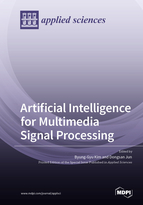Artificial Intelligence for Multimedia Signal Processing
A special issue of Applied Sciences (ISSN 2076-3417). This special issue belongs to the section "Computing and Artificial Intelligence".
Deadline for manuscript submissions: closed (30 June 2021) | Viewed by 49162
Special Issue Editors
Interests: image/video signal processing; pattern recognition; computer vision; deep learning; artificial intelligence
Special Issues, Collections and Topics in MDPI journals
Special Issue Information
Dear Colleagues,
At the ImageNet Large Scale Visual Re-Conversion Challenge (ILSVRC), a 2012 global image recognition contest, the University of Toronto Supervision team led by Prof. Geoffrey Hinton took first and second place by a landslide, sparking an explosion of interest in deep learning. Since then, global experts and companies such as Google, Microsoft, nVidia, and Intel have been competing to lead artificial intelligence technologies, such as deep learning. Now, they are developing deep-learning-based technologies applied to all industries and solving many classification and recognition problems.
These artificial intelligence technologies are also actively applied to broadcasting and multimedia processing technologies. A lot of research has been conducted in a wide variety of fields, such as content creation, transmission, and security, and these attempts have been made in the past two to three years to improve image, video, speech, and other data compression efficiency in areas related to MPEG media processing technology. Additionally, technologies such as media creation, processing, editing, and creating scenarios are very important areas of research in multimedia processing and engineering.
While this Special Issue invites topics broadly across advanced computational intelligence algorithms and technologies for emerging multimedia signal processing, some specific topics include but are not limited to:
- Signal/image/video processing algorithm for advanced deep learning;
- Fast and complexity reduction mechanism based on deep neural network;
- Protecting technologies for privacy/personalized media data;
- Advanced circuit/system design and analysis based on deep neural networks;
- Image/video-based recognition algorithm using deep neural network;
- Deep-learning-based speech and audio processing;
- Efficient multimedia sharing schemes using artificial intelligence;
- Artificial intelligence technologies for multimedia creation, processing, editing, and creating scenarios;
- Deep-learning-based web data mining and representation.
Prof. Dr. Byung-Gyu KimProf. Dr. Dongsan Jun
Guest Editors
Manuscript Submission Information
Manuscripts should be submitted online at www.mdpi.com by registering and logging in to this website. Once you are registered, click here to go to the submission form. Manuscripts can be submitted until the deadline. All submissions that pass pre-check are peer-reviewed. Accepted papers will be published continuously in the journal (as soon as accepted) and will be listed together on the special issue website. Research articles, review articles as well as short communications are invited. For planned papers, a title and short abstract (about 100 words) can be sent to the Editorial Office for announcement on this website.
Submitted manuscripts should not have been published previously, nor be under consideration for publication elsewhere (except conference proceedings papers). All manuscripts are thoroughly refereed through a single-blind peer-review process. A guide for authors and other relevant information for submission of manuscripts is available on the Instructions for Authors page. Applied Sciences is an international peer-reviewed open access semimonthly journal published by MDPI.
Please visit the Instructions for Authors page before submitting a manuscript. The Article Processing Charge (APC) for publication in this open access journal is 2400 CHF (Swiss Francs). Submitted papers should be well formatted and use good English. Authors may use MDPI's English editing service prior to publication or during author revisions.
Keywords
- Artificial/computational intelligence
- Image/video/speech signal processing
- Advance deep learning
- Learning mechanism
- Multimedia processing







